There is just something about these tiny little ecosystems we call nanos that many are drawn to. The idea that an entire world can exist in such a small space is very intriguing, and the fact that we constructed and maintain that tiny world can, perhaps, make us feel powerful. Setting up a nano can be a fun journey and for some people it is easier to enter the world of salt water keeping with little tanks, which usually equates less cost.
What is a nano?
A nano is just a small tank, salt or fresh water. For salt water tanks a nano usually refers to a tank less than 20 to 29 gallons. For fresh water a nano is usually 5 gallons and under. Nanos can be just a regular small aquarium, or they can be a specially made "nano" such as the biocube or picotope tanks, the only requirement is that they be small!
Why a nano?
Well, they don't take up as much space as a large aquarium. They are challenging, they can be cheaper than setting up a large aquarium, and, well they are fun. It can be fun selecting and maintaining plants, or in the case of marine nanos, corals that are small enough to fit into your tank.
Caring for a nano
Nano tanks can be more challenging than larger aquariums to care for. With less water to act as a buffer, things can wrong quickly. Many need frequent water changes, often a few times a week. At least the water changes are usually only a few gallons or less. Algae may grow quicker, and therefore the glass often needs to be cleaned more frequently. Pruning will need to be done much more frequently. With such a small space plants and corals need to be kept in check to ensure they do not overtake the aquarium. Essentially all the normal maintenance needs to be done more frequently, but it is at least on a small scale.
Disadvantages of a nano
What is also an advantage can also be a disadvantage here; space. While the aquarium itself won't take up to much of your living space its small size does not give the inhabitants much room. Many nanos can either only have a couple of tiny fish or invertebrates, or none at all. Some nanos can only have either plants or corals, with perhaps a snail or two. Anything more will overload the tank with biological wastes and crash it. Some might be able to house a few tiny fish such as celestial danios in the case of fresh water, or a single clown fish or pair of small gobies in a marine setup. The other disadvantage is that if things go wrong and you do not catch it immediatly you are almost certain to lose your livestock. The small amount of water does not do much to dilute wastes and toxins, which makes time a priority in the event of a fish dieing or anything else can happen to disrupt your water chemistry.
Whatever your reason for liking them, whether its financial, space or enjoying the challenge of the tiny many can agree there is just nothing quite like a nano!
Tuesday, December 22, 2009
The Allure Of Nanos
Posted by
Melgrj7
at
8:05 PM
0
comments
![]()
Labels: nano
Thursday, July 10, 2008
Selecting Your First Aquarium
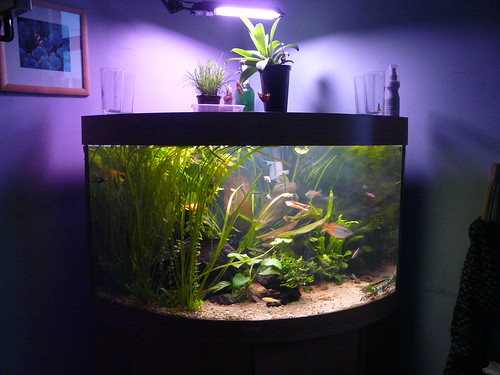
You've decided to take the plunge . . . you want an aquarium. So its easy right? You just go to the local fish store and grab a 10 gallon tank, a cheap filter, a heater some gravel and decorations, you think your all set. A couple of months later you are dismayed that your tank is full with only 8 or 9 small tropical fish, you have had to upgrade to a better filter and you couldn't get the fish you really wanted because they would get too big or aggressive for a tank of your size. Many people start out in the hobby this way. There is however a better way to go about it. It involves doing some research and waiting a little bit before getting your first aquarium.
Step One
The first step to acquiring an aquarium that you will be happy with is to go to the local fish stores and look at the fish. Bring a notepad and a pen with you and give yourself a good amount of time. Just look at the fish for awhile, write down the names of ones you like. Make notes about what it is you like about them. Maybe its the way they all swim together, perhaps the color, possibly the way it comes up to glass and looks right at you. Once you have gone to several local fish stores and have a good list of fish you can move on to step two.
Step Two
Now that you have a long list of fish that you like its time to jump online and do some research. Usually finding a good online fish group, such as TFA will be helpful in this area, you can ask questions and get answers from knowledgeable hobbyists. Things you want to find out about each type of fish are adult size, water chemistry needs (such hardness and pH), dietary needs (will the y need a special food?), temperature requirements and compatibility (are they aggressive, peaceful, like to live in groups or alone?). Once you have done your research on the type of fish you like, plan your tank. Decide which types you want to have, how many of each and how big they get. This will help you determine what size aquarium to get. While you are researching fish, get reviews on different products. Things to read about are filters, heaters and water conditioners. Doing your research now can pay off later as you will be able to avoid unnecessary purchases and tank upgrades. You will know that the oscar you really liked will need a 75 gallon aquarium all to itself within a years time and can save a couple hundred dollars by buying an appropriate sized aquarium the first time around. Once all of this is done you can move to step three.
y need a special food?), temperature requirements and compatibility (are they aggressive, peaceful, like to live in groups or alone?). Once you have done your research on the type of fish you like, plan your tank. Decide which types you want to have, how many of each and how big they get. This will help you determine what size aquarium to get. While you are researching fish, get reviews on different products. Things to read about are filters, heaters and water conditioners. Doing your research now can pay off later as you will be able to avoid unnecessary purchases and tank upgrades. You will know that the oscar you really liked will need a 75 gallon aquarium all to itself within a years time and can save a couple hundred dollars by buying an appropriate sized aquarium the first time around. Once all of this is done you can move to step three.
Step Three
Purchase your aquarium! All the hard work and research is done with and you can finally 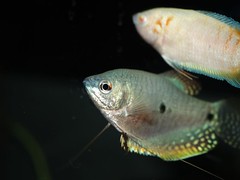 go to your locally owned fish store and get your supplies! Because you have done your research and planned out your aquarium you know what size aquarium you need, which filter you want, which heaters to avoid and that you don't need all those extra chemicals you see sitting on the shelves.
go to your locally owned fish store and get your supplies! Because you have done your research and planned out your aquarium you know what size aquarium you need, which filter you want, which heaters to avoid and that you don't need all those extra chemicals you see sitting on the shelves.
Doing some research ahead of time will make the aquarium hobby a more pleasant experience for you and the fish you decide to keep. Have fun with it!
Picture credits:
threefingeredlord, skippy13, Jarosław Pocztarski's,
Kasia/flickr
Posted by
Melgrj7
at
1:59 PM
3
comments
![]()
Labels: aquarium, first tank, fish tank, frist aquarium
Thursday, June 26, 2008
Otocinclus - The tiny algae eater
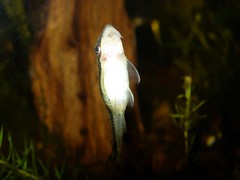
Otocinclus are a favorite among planted tank enthusiasts. They are small in stature, never exceeding 2 inches, and do a great job and gently cleaning algae off of plant leaves and the aquarium glass. They are also fun to watch as they often swim together in groups, mid-water, unlike many other fish commonly used as algae control. There are 16 known species of Otocinclus, the most common being O. affinis.
These little algae eating gems are found in oxygen rich streams in South America, from northern Venezuela to northern Argentina. They are not normally found in the Amazon and Orinoco lowlands. The streams they are usually found in have a low pH and have a slow to moderate flow. They are often found near the banks, in large schools.
In the aquarium these fish can be a bit difficult to acclimatize, but once they are they seem to be pretty hardy and adaptable. They do best if kept in groups of 3 or more. They can be kept in both small and larger aquariums. They do an excellent job of eating most algae from decorations, plants and the glass. They do such a good job that they often need to be fed algae wafers to supplement their diet.
picture credit: elpono_njg
Posted by
Melgrj7
at
12:52 PM
1 comments
![]()
Labels: otocinclus
Saturday, February 23, 2008
Enrichment
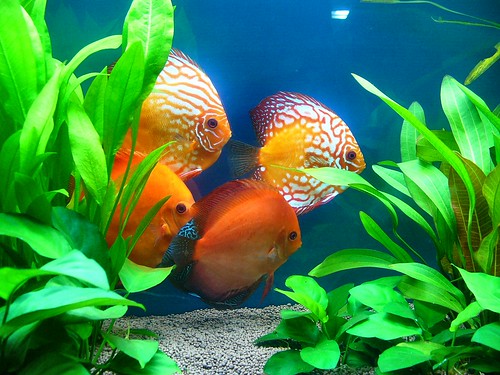 Enrichment
Enrichment
When people talk about enrichment and animals they are usually talking about enriching the lives of creatures like tigers, apes and parrots. Often not much thought is given to enriching the lives of fish. Many fish however have been shown to have some intelligence. Even guppies can count to the number four! Cichlids have often been considered very intelligent fish and many would do well to have some enrichment. With this in mind, perhaps it is time to start looking into how we can enrich the lives of our aquatic pals.
What is enrichment?
When we talk about enrichment concerning animals we are referring to improving their lives, stimulating them. Enrichment is a common topic among many institutions, such as zoos, that have animals. When looking to enrich an animals life its a good idea to start by looking at how they would normally behave in the wild and try to offer things that may trigger similar behaviors. For example, with many mammalian predators, keepers will often hide their food so they have to "hunt for it". Or they will put in large balls or other things that move when the animal touches it and this stimulates a prey drive. Primates are often offered puzzles and other things that stimulate their intellect. Without enrichment many captive animals become extremely bored, obese and some may even exhibit bizarre behaviors.
Enriching The Lives Of Fish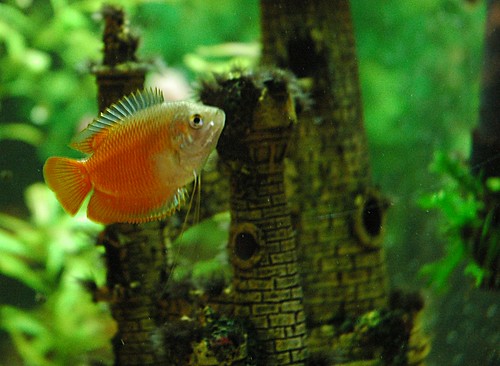
So, how would one go about enriching the lives of fish? Well, that would depend on the type of fish. For many fish, simply having tankmates and an interesting environment with a lot of visual barriers will be enrichment enough. For others you may need to get creative and utilize ping pong balls, a mirror or even a squeaky toy! Food can perhaps be one of the best enrichment tools available to animal keepers, try to get creative.
Tankmates
Tankmates can provide plenty of entertainment for many fish. Schooling fish such as barbs, tetras, rasboras and many more benefit most from being in groups of 6 or more of their own kind (for example, 6 neon tetras, not 1 each of 6 different tetras). They will spend most of their day reacting to each other, displaying, and working out their social hierarchy. Rock dwelling African cichlids spend much of their time in both the wild and captivity stealing and protecting favorite rock outcroppings and caves from each other. If your lone fish seems sedentary and bored with life, consider upgrading its tank size and adding some tankmates. Remember to research first what types of fish can live together. Environment
Environment
Use fake or live plants, driftwood pieces or other decorations to create a dynamic aquascape. Try to position decorations so that if the fish is in one section of the tank, it cannot see the other side without moving. This will stimulate most fish to always be on the move to check out what's "over there". If you have multiple fish this can also be a necessity, as it will give fish a break from each other if the needs arrives. Many fish, like botias and loaches love to check out caves and little nooks and crannies. You can make an interesting cave and tunnel system with PVC pieces, just make sure they are big enough in diameter that the fish won't get stuck. African cichlids also often enjoy PVC pieces. If you want a more natural look, use rocks and aquarium safe wood instead of PVC. For top dwelling fish, add floating plants (live or fake) and perhaps add a piece of wood that reaches all the way to the surface.
You need a big enough space to create an interesting environment. Try to avoid overstocking your tank with many small fish. If you have large fish, ensure the aquarium is large enough for the fish and some decorations.
Toys
Many large fish are kept by themselves because of the amount of tank space it would take to have appropriate tankmates. Oscars are a prime example. Many live alone in 75 gallon tanks with not much to do all day. Other fish live alone because they are aggressive or because they can survive in a smaller tank that only has room for one fish (bettas for example). Many of these fish are some of the most intelligent, and yet they are often the ones relegated to the most boring existence. Many of these fish will benefit from toys to play with, yes toys. Many larger cichlids will "play" with a floating ping pong ball, or will check out and manipulate with their mouths new items in their territory. One oscar seemed to enjoy a dog toy, it was a small squeaky toy. The oscar would carry it around, biting on it. Some toys can be used to hide food in, so the fish has to work to get its meal. If you decide to use a toy for your fish, make sure it will not negatively affect the aquarium water. With bettas, holding up a small mirror for a minute or so a day will initiate a threat display and give the betta some excellent exercise. They often appear to "feel proud" of themselves when the mirror is put away, for having chased away the opponent. You can even teach your fish to do tricks . . . such as play soccer, basket ball, or swim through hoops.
Food As An Enrichment Tool
Food can perhaps be one of the best enrichment tools available to keepers. One of the biggest delights of many aquarium keepers is feeding time. The fish become animated, excited. Its nice to see them enjoying something. Most people just toss in some flakes or pellet foods and in a minute, or even just a few seconds, it is over. In the wild fish have to work for their food. Finding and getting food preoccupies much of their day. In captivity it is something that takes up perhaps just a few seconds, once, maybe twice a day. So, how do you go about making eating more interesting? Well, that will depend on how your fish eat. You would feed a top dwelling fish differently than a bottom dweller and grazers differently than a predator.
Try adding live foods fairly often, such as brine shrimp. They will have to hunt them down and will often spend some time after they have eaten them all, looking for more. If brine shrimp are too small for your fish, try ghost shrimp instead. If you don't have access to live foods, put frozen foods into the filter current so they have to chase them down. Feed different types of foods, alternate between a flake food, a floating pellet and a slow sinking pellet. Feed in a different area, alternate sporadically between the left of the tank, the right, the middle, the front and the back. Try adding a live food that can survive and breed in the tank, such as a species of fresh water shrimp. Some people have successfully been able to keep a small population of daphnia alive in their aquarium. For bottom dwelling and grazing type fish (catfish; goldfish), drop one pellet here, one there, don't just drop them all in one spot. For predators, put food on the end of a feeding wand an make them stalk and hunt down their food. Many herbivorous fish, such as goldfish or silver dollars, will enjoy eating live plants; drop a bunch of anacharis (elodea) in the tank once in awhile. Some fish can learn to put a ball through a hoop or ring a bell to get fed. Again, just be creative and mix it up, your fish will appreciate it.
When it comes to enriching the lives of our aquarium fish it can be as simple as adding some tankmates and decorations, or as complicated as giving them toys to chase and push around, or rigging up an underwater basket ball game. Even the simplest forms of enrichment can make a huge improvement on their lives.
Interesting links:
Underwater Times: Man Trains Goldfish
Fish School - How To Train Your Fish
Picture credits:
loloieg, doviende, Whisper Photography, Tom@HK
Posted by
Melgrj7
at
11:43 PM
0
comments
![]()
Labels: aquarium, decoration, enrichment, fish feeding, toys, training fish
Saturday, February 9, 2008
Dealing With Burn Out
Dealing With Burn Out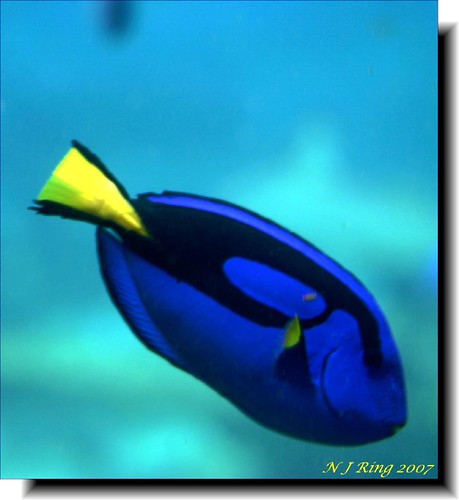
Burn out
No, I'm not referring to water dripping onto one of your many electrical strips, I am talking about something that happens to many hobbyist at one point or another. As you are going along doing your water changes you suddenly realize that your tanks have turned into a chore rather than a pleasure. You used to get a thrill out of your tanks, seeing baby fish or a new plant pop up. Now when you gaze in the direction of your tank or fish room you get a long list of "to-dos" popping up in your head. You find yourself avoiding the tanks, diverting your eyes from the multitudes of little fish. You go longer between doing your water changes, you aren't as diligent about dosing your fertilizers or supplements. Your bulbs go unchanged. You derive little pleasure from you once highly enjoyed hobby. What happened? You have burned out.
Whats The Cause?
Burn out can happen to anyone, whether they have one tank or hundreds. Whether they have been in the hobby for 20 years or one. What causes it? Well, that is probably different for everyone. As humans our interests do change over time. Perhaps you now find that orchids or glass blowing gives you your thrills. Maybe your life has become busy and time is just something you don't have to spare. For some people, once their tanks are set up and they are not out buying new fish and selecting plants and researching who can live with who boredom sets in. What ever the cause, it does happen.
How To Handle It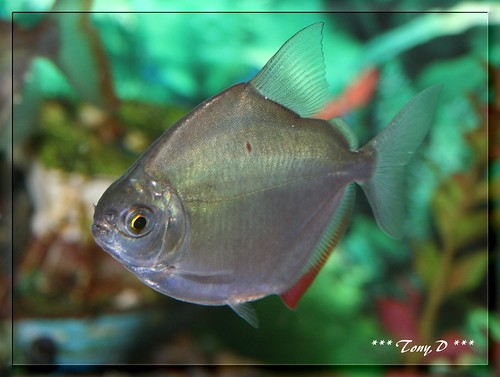 Many people, when they "burn out" take down their tanks give their fish away and leave the hobby for a while until they are bit by the bug again. Many others continue on with their haphazard maintenance and their fish and plants suffer. If you want to keep your tank up and running but just need a little boost in enthusiasm for the hobby try a few of the following things.
Many people, when they "burn out" take down their tanks give their fish away and leave the hobby for a while until they are bit by the bug again. Many others continue on with their haphazard maintenance and their fish and plants suffer. If you want to keep your tank up and running but just need a little boost in enthusiasm for the hobby try a few of the following things.
1. New is exciting, redo your tank. Trade your fish in, redecorate and try different fish. Setting up a new tank is often very exciting for people and this may just be what you need. If you have been keeping fancy guppies forever, try something completely different, like cichlids. If you are keeping a reef tank, try switching to fancy goldfish. A change may just be your cure.
2. Join an aquarium club. Excitement and enthusiasm are contagious! Surround yourself with others who enjoy the hobby. You can get new ideas, trade fish and just have a good time chatting about the hobby.
3. Spend time just enjoying your tank. If all you do is maintenance on your tank and you never sit back to enjoy the fruits of your labor it can be very easy to burn out. Try moving your tank somewhere that you can easily see it.
4. Try less tanks. If you have a huge fish room with tons of tanks all over, try taking some down and focusing on just a few display tanks or on just breeding a couple of species that interest you.
5. Go to the next level. Have you mastered keeping the tropical community tank? M aybe you are ready to go to the next level and start breeding or head into salt water fish keeping.
aybe you are ready to go to the next level and start breeding or head into salt water fish keeping.
6. Make it easier. Invest in automatic water changing systems, feeders and dosers or hire someone who does tank maintenance. If you have less work to do on your tank you will probably enjoy it more, not to mention that playing with new gadgets is always fun. Also, this way, if you are burnt out your fish will not suffer the consequences.
If you find you just can't muster up enthusiasm for the hobby you once enjoyed, perhaps it is time to take a break. Remember that the fish rely on you for their survival and if you are dreading working your tank you are less likely to take as good care of it. Besides, why do something you don't enjoy? Many people find they just need a break for a couple of years. If you decide you need a break, I highly recommend you keep all of your equipment in storage as the fish bug often bites again.
Photo credits in order of appearance: nellring, tkcrash123, threefingeredlord
Posted by
Melgrj7
at
1:26 PM
0
comments
![]()


